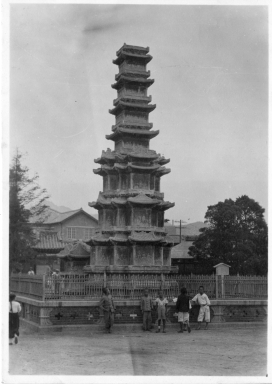Pagodas are iconic structures that have been prevalent in the architecture and culture of various Asian countries for centuries. The origins of pagodas can be traced back to ancient India, where they were known as stupas and were used as a place of worship for Buddhists. According to Britanica, “The pagoda structure derives from that of the stupa, a hemispherical, domed, commemorative monument first constructed in ancient India. Initially, these structures symbolized sacred mountains, and they were used to house relics or remains of saints and kings. Stupas evolved into several distinct forms in various parts of Asia,” (Britanica, 2019). As Buddhism spread across Asia, so did the design and construction of pagodas, with each country putting its unique spin on the structure.
As stated by The Chinese Historical and Culural Project, “The pagoda, or ta in Chinese, made its first appearance in China about 68 A.D. when Buddhism arrived from India. As the religion spread during the sixth century, from China to Japan and Korea, the pagoda became a defining form in religious architecture,” (CHCP, 2023). In China, pagodas were initially constructed with timber and had a more rectangular shape. However, over time, the design evolved to include more tiers and a more curved structure. In Japan, pagodas were constructed with a more curved and slender shape, with the iconic five-story pagoda being the most popular design.
In Korea, pagodas were built with a similar structure to those in China, but with a distinct twist. Korean pagodas were often constructed with bricks and had a more square-shaped base. Now let’s turn to the image itself and what it can tell us about the history, contemporary state, and future of the location it was taken. This unique design can be seen in the Wongaksa Pagoda in Tapgol Park, which is the focus of the photograph by Kane, Albert E. The photograph of the Pagoda in Tapgol Park in Seoul tells us about the history of the location. The Pagoda was built during the Joseon Dynasty and has stood the test of time, surviving the Japanese occupation and the Korean War. Japanese occupation of Korea, which began in 1910 and lasted until 1945. During this time, the Japanese government sought to assimilate Korea into Japanese culture and society, which included changing the name of Seoul to Keijo. The fact that the title of the photo uses the Japanese name for Seoul is indicative of this period of forced assimilation. Asia Society mentions that, “When Japan forcibly took over Choson as a colonial ruler in 1910, it made attempts to assimilate Korean Buddhist sects with those of Japan. These attempts however failed and even resulted in a revival of interest in native Buddhism among Koreans,” (Asian Society, 2001). The park, which was previously known as Pagoda Park, has also played a significant role in Korean history, being the site of numerous protests against Japanese rule. The photograph also tells us about the contemporary location. The Wongaksa Pagoda is now located in Tapgol Park, a popular tourist attraction in Seoul. The park is surrounded by towering skyscrapers, showcasing the contrast between traditional Korean architecture and modern development. The children posing in front of the Pagoda suggest that it continues to be an important cultural and historical symbol for the local community.
The future of the location is uncertain, as the rapid development and modernization of Seoul could potentially threaten the preservation of historical sites like Tapgol Park and the Wongaksa Pagoda. However, the fact that the park and pagoda have survived numerous challenges throughout history suggests that they will continue to stand as a symbol of Korean heritage for future generations.
The meaning of the image for the artist/photographer, Kane, Albert E., is unclear, as there is little information available about his intentions or motivations. However, the photograph captures the beauty and intricacy of the Wongaksa Pagoda, showcasing its unique square-shaped base and intricate design. The children posing in front of the Pagoda suggest that it continues to be an important cultural symbol for the local community, which may have been of interest to the photographer. For the local people and place being depicted, the photograph of the Wongaksa Pagoda in Tapgol Park is a reminder of the rich history and cultural heritage of Seoul. The Pagoda and the park have played a significant role in Korean history, and their continued existence serves as a symbol of resilience and perseverance.
In conclusion, the photograph of the Wongaksa Pagoda in Tapgol Park provides valuable insights into the history, present, and future of the location. It highlights the unique design of Korean pagodas, showcases the cultural and historical significance of the Pagoda and park, and serves as a reminder of the resilience of the Korean people in the face of adversity. As such, the photograph is an important contribution to the visual history of Korea and a testament to the enduring power of cultural heritage.
